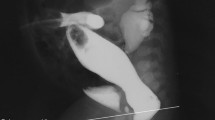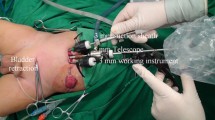Abstract
Purpose
Laparoscopic-assisted anorectoplasty (LAARP) is becoming a more popular procedure for anorectal malformation (ARM) repair. However, the conventional technique for creating pull-through tunnel between the perineal skin and the pelvic floor has been criticized as being semi-blind. This study aims to present a refined version of our previously reported clamp introduction technique for visualized tunnel formation in the center of the sphincter muscle complex (SMC) for rectal pull- through for ARMs.
Methods
A retrospective review was performed for ARM patients who underwent LAARP from Jan 2019 to Jun 2020. Longitudinal muscle tube (LMT) tunnel was created using the clamp-dilator introduction technique: a laparoscopic dilator was used to create a pelvic tunnel within LMT in high ARM, and the clamp introduction under the direct vision technique was performed for creating the perineal tunnel of LMT for both high and intermediate ARMs.
Results
Seventy patients (1–198 days) with high-type (27cases) and intermediate-type (43 cases) ARM underwent LAARP using clamp-dilation introduction technique. No patients suffered from urinary tract injury, recurrent rectourethral fistula, urethral diverticulum and urinary incontinence. One patient suffered from wound infection and rectal retraction which required a redo pull-through on postoperative day 7. Rectal prolapse requiring surgical intervention developed in one patient. Postoperative MRI examination confirmed central placement of the rectum within the LMT in all cases.
Conclusion
Our experience demonstrates that a visualized tunnel formation in the LMT center can be achieved by the clamp-dilator introduction technique in LAARP for both high and intermediate ARMs






Similar content being viewed by others
References
Georgeson KE, Inge TH, Albanese CT (2000) Laparoscopically assisted anorectal pull-through for high imperforate anus–a new technique. J Pediatr Surg 35(6):927–931. https://doi.org/10.1053/jpsu.2000.6925
England RJ, Warren SL, Bezuidenhout L et al (2012) Laparoscopic repair of anorectal malformations at the Red Cross War Memorial Children’s Hospital: taking stock. J Pediatr Surg 47(3):565–570. https://doi.org/10.1016/j.jpedsurg.2011.08.006
Tainaka T, Uchida H, Tanaka Y et al (2018) Long-term outcomes and complications after laparoscopic-assisted anorectoplasty vs. posterior sagittal anorectoplasty for high- and intermediate-type anorectal malformation. Pediatr Surg Int 34(10):1111–1115. https://doi.org/10.1007/s00383-018-4323-4
Yazaki Y, Koga H, Ochi T et al (2016) Surgical management of recto-prostatic and recto-bulbar anorectal malformations. Pediatr Surg Int 32(10):939–944. https://doi.org/10.1007/s00383-016-3948-4
Tei E, Yamataka A, Segawa O et al (2003) Laparoscopically assisted anorectovaginoplasty for selected types of female anorectal malformations. J Pediatr Surg 38(12):1770–1774. https://doi.org/10.1016/j.jpedsurg.2003.08.018
Li L, Ren X, Ming A et al (2020) Laparoscopic-assisted anorectoplasty for intermediate type rectovestibular fistula: a preliminary report. Pediatr Surg Int 36(10):1213–1219. https://doi.org/10.1007/s00383-020-04730-z
Cairo SB, Rothstein DH, Harmon CM (2017) Minimally invasive surgery in the management of anorectal malformations. Clin Perinato 44(4):819–834. https://doi.org/10.1016/j.clp.2017.08.007
Georgeson K (2007) Laparoscopic-assisted anorectal pull-through. Semin Pediatr Surg 16(4):266–269. https://doi.org/10.1053/j.sempedsurg.2007.06.009
Bischoff A, Levitt MA, Peña A (2011) Laparoscopy and its use in the repair of anorectal malformations. J Pediatr Surg 46(8):1609–1617. https://doi.org/10.1016/j.jpedsurg.2011.03.068
Diao M, Li L, Ye M et al (2016) Congenital anomaly rectified at birth: one-stage single-incision laparoscopic-assisted anorectoplasty for newborns with anorectal malformations and recto-urethral fistula. Surg Endosc 30(11):5156–5164. https://doi.org/10.1007/s00464-016-4841-x
Li L, Ren X, Ming A et al (2020) Laparoscopic surgical technique to enhance the management of anorectal malformations: 330 cases’ experience in a single center. Pediatr Surg Int 36(3):279–287. https://doi.org/10.1007/s00383-019-04614-x
Holschneider A, Hutson J, Peña A et al (2005) Preliminary report on the international conference for the development of standards for the treatment of anorectal malformations. J Pediatr Surg 40(10):1521–1526. https://doi.org/10.1016/j.jpedsurg.2005.08.002
DeVries PA (1984) The surgery of anorectal anomalies: its evolution, with evaluation of procedures. Curr Probl Surg 21:1–75. https://doi.org/10.1016/0011-3840(84)90008-x
Li L, Ren X, Xiao H et al (2020) Normal anorectal musculatures and changes in anorectal malformation. Pediatr Surg Int 36(1):103–111. https://doi.org/10.1007/s00383-019-04583-1
Yamataka A, Segawa O, Yoshida R et al (2001) Laparoscopic muscle electrostimulation during laparoscopy-assisted anorectal pull-through for high imperforate anus. J Pediatr Surg 36(11):1659–1661. https://doi.org/10.1053/jpsu.2001.27944
Iwanaka T, Arai M, Kawashima H et al (2003) Findings of pelvic musculature and efficacy of laparoscopic muscle stimulator in laparoscopy-assisted anorectal pull-through for high imperforate anus. Surg Endosc 17(2):278–281. https://doi.org/10.1007/s00464-002-9054-9
Rintala RJ, Lindahl H (1995) Is normal bowel function possible after repair of intermediate and high anorectal malformations? J Pediatr Surg 30(3):491–494. https://doi.org/10.1016/0022-3468(95)90064-0
Iwai N, Hashimoto K, Goto Y et al (1984) Long-term results after surgical correction of anorectal malformations. Z Kinderchir 39(1):35–39. https://doi.org/10.1055/s-2008-1044166
Peña A (1995) Anorectal malformations. Semin Pediatr Surg 4(1):35–47
Funding
None.
Author information
Authors and Affiliations
Corresponding authors
Ethics declarations
Conflict of interest
The authors have no conflict of interest to disclose.
Research involving human participants
Ethical approval was obtained from the Ethics Committee of the Capital Institute of Pediatrics.
Informed consent
Written informed consents were obtained from the parents before surgery.
Additional information
Publisher's Note
Springer Nature remains neutral with regard to jurisdictional claims in published maps and institutional affiliations.
Rights and permissions
About this article
Cite this article
Li, L., Ming, A., Zhou, Y. et al. Refinements in surgical techniques for visualized tunnel formation in laparoscopic-assisted anorectoplasty. Pediatr Surg Int 37, 999–1005 (2021). https://doi.org/10.1007/s00383-021-04909-y
Accepted:
Published:
Issue Date:
DOI: https://doi.org/10.1007/s00383-021-04909-y




